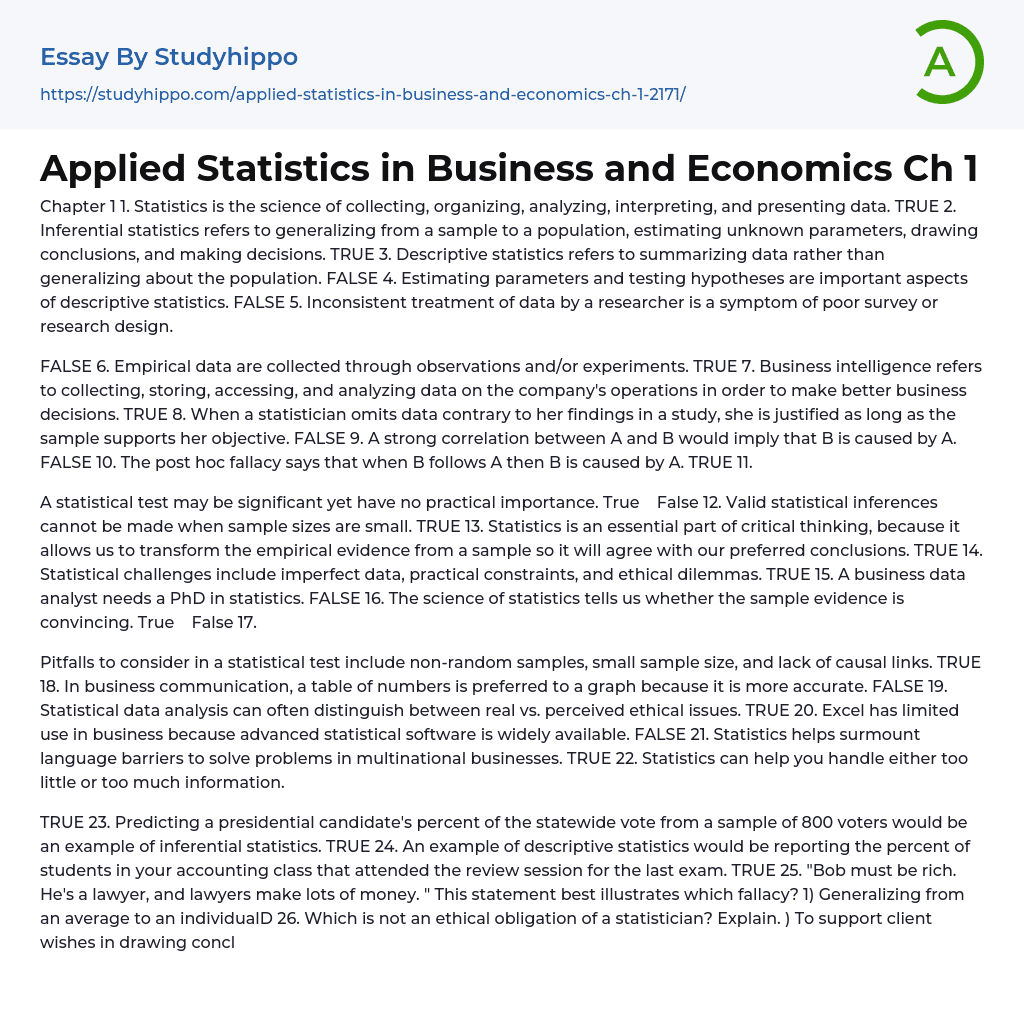

Applied Statistics in Business and Economics: Questions and Answers Essay Example
Topics:
View Entire Sample
Download Sample
Text preview
- Statistics is the science of collecting, organizing, analyzing, interpreting, and presenting data. TRUE
- Inferential statistics refers to generalizing from a sample to a population, estimating unknown parameters, drawing conclusions, and making decisions. TRUE
- Descriptive statistics refers to summarizing data rather than generalizing about the population. FALSE
- Estimating parameters and testing hypotheses are important aspects of descriptive statistics. FALSE
- Inconsistent treatment of data by a researcher is a symptom of poor survey or research design. FALSE
- Empirical data are collected through observations and/or experiments. TRUE
- Business intelligence refers to collecting, storing, accessing, and analyzing data on the company's operations in order to make better business decisions. TRUE
- When a statistician omits data contrary to her findings in a study, she is justified as long as the sample supports her ob
...jective. FALSE
- A strong correlation between A and B would imply that B is caused by A. FALSE
- The post hoc fallacy says that when B follows A then B is caused by A. TRUE
- A statistical test may be significant yet have no practical importance. True
- False Valid statistical inferences cannot be made when sample sizes are small. TRUE
- Statistics is an essential part of critical thinking, because it allows us to transform the empirical evidence from a sample so it will agree with our preferred conclusions. TRUE
- Statistical challenges include imperfect data, practical constraints, and ethical dilemmas. TRUE
- A business data analyst needs a PhD in statistics. FALSE
- The science of statistics tells us whether the sample evidence is convincing. True
- Pitfalls to consider in a statistical test include non-random samples, small sample size, and lack of causal links. TRUE
- In business communication, a
View entire sampleJoin StudyHippo to see entire essay
table of numbers is preferred to a graph because it is more accurate. FALSE
Popular Essay Topics
- Accounting essays
- Marketing essays
- Automation essays
- Business Cycle essays
- Business Model essays
- Business Operations essays
- Business Software essays
- Corporate Social Responsibility essays
- Infrastructure essays
- Logistics essays
- Manufacturing essays
- Multinational Corporation essays
- Richard Branson essays
- Small Business essays
- Cooperative essays
- Family Business essays
- Human Resource Management essays
- Sales essays
- Market essays
- Online Shopping essays
- Selling essays
- Strategy essays
- Management essays
- Franchising essays
- Quality Assurance essays
- Business Intelligence essays
- Corporation essays
- Stock essays
- Shopping Mall essays
- Harvard Business School essays
- Harvard university essays
- Trade Union essays
- Cooperation essays
- News Media essays
- Waste essays
- Andrew Carnegie essays
- Inventory essays
- Customer Relationship Management essays
- Structure essays
- Starting a Business essays
- Accounts Receivable essays
- Auditor's Report essays
- Balance Sheet essays
- Costs essays
- Financial Audit essays
- International Financial Reporting Standards essays
- Tax essays
- Accountability essays
- Cash essays
- Principal essays



